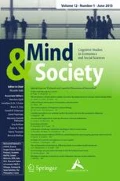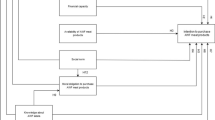Abstract
The European market has faced a series of recurrent food scares, e.g. mad cow disease, chicken flu, dioxin poisoning in chickens, salmons and recently also in pigs (Italian newspaper “Corriere della Sera”, 07/12/2008). These food scares have had, in the short term, major socio-economic consequences, eroding consumer confidence and decreasing the willingness to buy potentially risky food products. The research reported in this paper considered the role of commitment to a food product in the context of food scares, and in particular the effect of commitment on the purchasing intentions of consumers, on their attitude towards the product, and on their trust in the food supply chain. After the initial commitment had been obtained, a threat scenario evoking a risk associated with a specific food was presented, and a wider, related request was then made. Finally, a questionnaire tested the effects of commitment on the participants’ attitude towards the product. The results showed that previous commitment can increase consumers’ behavioural intention to purchase and their attitude towards the food product, even in the presence of a potential hazard.

Similar content being viewed by others
Notes
A notorious case of dioxin contamination in chicken was reported in Belgium in 1999 (“La Repubblica”, 23/07/1999). Salmon fishing was halted in Denmark owing to high levels of dioxin concentration (“Corriere della Sera”, 01/04/2004).
The description of the dioxin cycle is based on actual scientific information, adapted from an article in the journal Altroconsumo. The journal Altroconsumo is published by the consumer association of the same name.
Eurobarometer report number 52.1 “The Europeans and biotechnology”, from the Public Opinion Analysis unit of the European Commission, published on 15th March, 2000.
Data published by the UK Meat and Livestock Commission. Note the 1996 was one of the most dramatic years of “mad cow” crisis and that other concomitant factors may have contributed to this decrease.
In an independent study we found a strong hedonic attitude for salmon and this effect was significantly higher compared to the hedonic attitude for chicken.
References
Ajzen I (1991) The theory of planned behavior. Organ Behav Hum Dec 50(2):179–211
Ajzen I (2001) Nature and operation of attitudes. Annu Rev Psychol 52:27–58
Ajzen I, Fishbein M (2000) Attitudes and the attitude—behaviour relation: reasoned and automatic processes. In: Stroebe W, Hewstone M (eds) European review of social psychology. Wiley, Chichester, pp 1–33
Bem DJ (1967) Self-perception: an alternative interpretation of cognitive dissonance phenomena. Psychol Rev 74(3):183–200
Brehm JW (1960) Attitudinal consequences of commitment to unpleasant behavior. J Abnorm Soc Psych 60(3):379–383
Cialdini RB (1993) Influence: science and practice, 3rd edn. HarperCollins College Publishers, New York
Cialdini RB, Bassett R, Cacioppo JT, Miller JA (1978) Low-ball procedure for producing compliance: commitment then cost. J Pers Soc Psychol 36(5):463–476
Cook AJ, Kerr GN, Moore K (2002) Attitudes and intentions towards purchasing GM food. J Econ Psychol 23(5):557–572
Eagley AH, Chaiken S (1993) The psychology of attitudes. Harcourt Brace, Fort Worth
Festinger L (1957) A theory of cognitive dissonance. Peterson, Oxford
Flynn J, Slovic P, Kunreuther H (2001) Risk, media and stigma: understanding public challenges to modern science and technology. Earthscan, London
Freedman JL, Fraser SC (1966) Compliance without pressure: the foot-in-the-door technique. J Pers Soc Psychol 4(2):195–202
Frewer LJ, Howard C, Hedderley D, Shepherd R (1996) What determines trust in information about food related risk? Underlying psychological constructs. Risk Anal 16(4):473–486
Huskinson TLH, Haddock G (2004) Individual differences in attitude structure: variance in the chronic reliance on affective and cognitive information. J Exp Soc Psychol 40(1):82–90
Joule RB (1987) Tobacco deprivation: the foot-in-the-door technique versus the low-ball technique. Eur J Soc Psychol 17(3):361–365
Joule RB, Azdia T (2003) Cognitive dissonance, double forced compliance, and commitment. Eur J Soc Psychol 33(3):565–571
Kahneman D, Ritov I, Schkade D (1999) Economic preferences or attitude expressions? An analysis of dollar responses to public issues. J Risk Uncertain 19(1):223–235
Kelley HH (1973) The process of causal attribution. Am Psychol 28(2):107–128
Kiesler CA, Sakumura J (1966) A test of a model for commitment. J Pers Soc Psychol 3(3):349–353
Kimenju SC, De Groote H (2008) Consumer willingness to pay for genetically modified food in Kenya. Agr Econ 38(1):35–46
Maio GR, Olson JM (1998) Attitude dissimulation and persuasion. J Exp Soc Psychol 34(2):182–201
Mayer RC, Davis JH (1999) The effect of the performance appraisal system on trust for management: a field quasi-experiment. J Appl Psychol 84(1):123–136
Mayer RC, Davis JH, Schoorman FD (1995) An integrative model of organizational trust. Acad Manage Rev 20(3):709–734
Mazzocchi M, Lobb A, Traill WB, Cavicchi A (2008) Food scares and trust: a European study. J Agr Econ 59(1):2–24
Moriarty T (1975) Crime, commitment, and the responsive bystander: two field experiments. J Pers Soc Psychol 31(2):370–376
Osgood CE, Suci GJ, Tannenbaum PH (1957) The measurement of meaning. University of Illinois Press, Champaign
Pennings JME, Wansink B, Meulenberg MTG (2002) A note on modelling consumer reactions to a crisis: the case of the mad cow disease. Int J Res Mark 19(1):91–100
Selnes F (1998) Antecedents and consequences of trust and satisfaction in buyer-seller relationships. Eur J Mark 32(3–4):305–322
Siegrist M (2000) The influence of trust and perceptions of risks and benefits on the acceptance of gene technology. Risk Anal 20(2):195–203
Siegrist M, Cvetkovich G (2000) Perception of hazards: the role of social trust and knowledge. Risk Anal 20(5):713–719
Siegrist M, Cousin M, Kastenholz H, Wiek A (2007) Public acceptance of nanotechnology foods and food packaging: the influence of affect and trust. Appetite 49(2):459–466
Tepper BJ, Choi Y, Nayga RMJR (1997) Understanding food choice in adult men: influence of nutrition knowledge, food beliefs and dietary restraint. Food Qual Prefer 8(4):307–317
Acknowledgments
This research was supported by the European Commission, Quality of Life Programme, Key Action 1—Food, Nutrition, and Health, Research Project “Food Risk Communication and Consumers’ Trust in the Food Supply Chain—TRUST” (Contract no. QLK1-CT-2002-02343). Principal investigator of the University of Trento Unit: Prof. Nicolao Bonini. Furthermore, we would like to thank Dr. Luigi Lombardi for his helpful comments on the various statistical analyses.
Author information
Authors and Affiliations
Corresponding author
Appendices
Appendix A: Questions on trust and attitude
-
(Q1)
(TRUST) To what extent do you trust Italian salmon [chicken] breeders? (1 = not at all; 5 = completely)
-
(Q2)
(TRUST) To what extent do you trust Italian salmon [chicken] suppliers? (1 = not at all; 5 = completely)
-
(Q3)
(TRUST) To what extent do you trust Italian authorities in charge of fish [meat] products safety? (1 = not at all; 5 = completely)
-
(Q4)
(COMPETENCE) How much do you think that Italian salmon [chicken] breeders are competent in their work? (1 = not at all; 5 = completely)
-
(Q5)
(COMPETENCE) How much do you think that Italian salmon [chicken] suppliers are competent in their work? (1 = not at all; 5 = completely)
-
(Q6)
(COMPETENCE) How much do you think that Italian authorities in charge of fish [meat] products safety are competent in their work? (1 = not at all; 5 = completely)
-
(Q7)
(BENEVOLENCE) How much do you think that Italian salmon [chicken] breeders are concerned about your health? (1 = not at all; 5 = completely)
-
(Q8)
(BENEVOLENCE) How much do you think that Italian salmon [chicken] suppliers are concerned about your health? (1 = not at all; 5 = completely)
-
(Q9)
(BENEVOLENCE) How much do you think that Italian authorities in charge of fish [meat] products safety are concerned about your health? (1 = not at all; 5 = completely)
-
(Q10)
(SHARED VALUES) How much do you think that Italian salmon [chicken] breeders share your same values? (1 = not at all; 5 = completely)
-
(Q11)
(SHARED VALUES) How much do you think that Italian salmon [chicken] suppliers share your same values? (1 = not at all; 5 = completely)
-
(Q12)
(SHARED VALUES) How much do you think that Italian authorities in charge of fish [meat] safety share your same values? (1 = not at all; 5 = completely)
-
(Q13)
(TRUTHFULNESS OF INFORMATION) How much do you trust Italian salmon [chicken] breeders to tell the truth about chicken meat? (1 = not at all; 5 = completely)
-
(Q14)
(TRUTHFULNESS OF INFORMATION) How much do you trust Italian salmon [chicken] suppliers to tell the truth about chicken meat? (1 = not at all; 5 = completely)
-
(Q15)
(TRUTHFULNESS OF INFORMATION) How much do you trust Italian authorities in charge of fish [meat] safety to tell the truth about chicken meat? (1 = not at all; 5 = completely)
-
(Q16)
(ATTITUDE) Personally, do you think that salmon [chicken] consumption is a __?__ behavior:

Appendix B: Factors loadings of the attitude scales for salmon and chicken consumption
Salmon | Chicken | |||||
|---|---|---|---|---|---|---|
1—MF (26% of variance) | 2—HF (25% of variance) | 3—IF (18% of variance) | 1—IF (26% of variance) | 2—MF (25% of variance) | 3—HF (20% of variance) | |
Ignoble–noble | 0.878 | 0.124 | 0.046 | 0.155 | 0.890 | 0.108 |
Despicable–admirable | 0.864 | 0.117 | 0.214 | 0.185 | 0.833 | 0.163 |
Shameful–laudable | 0.680 | 0.292 | 0.367 | 0.601 | 0.584 | 0.267 |
Wrong–right | 0.665 | 0.401 | 0.394 | 0.423 | 0.682 | 0.299 |
Useless–useful | 0.629 | 0.287 | 0.321 | 0.481 | 0.607 | 0.226 |
Boring–exciting | 0.591 | 0.361 | –0.090 | 0.263 | 0.664 | 0.318 |
Ugly–nice | 0.490 | 0.443 | 0.354 | 0.178 | 0.673 | 0.352 |
Bad–good | 0.055 | 0.834 | 0.150 | 0.298 | 0.191 | 0.748 |
Negative–positive | 0.219 | 0.793 | 0.329 | 0.359 | 0.181 | 0.813 |
Disagreeable–agreeable | 0.302 | 0.727 | 0.122 | 0.297 | 0.351 | 0.621 |
Unpleasant–pleasant | 0.277 | 0.676 | 0.228 | 0.127 | 0.262 | 0.761 |
Harmful–beneficial | 0.413 | 0.617 | 0.360 | 0.532 | 0.200 | 0.660 |
Foolish–wise | 0.521 | 0.592 | 0.340 | 0.608 | 0.459 | 0.390 |
Unreasonable–reasonable | 0.478 | 0.548 | 0.421 | 0.712 | 0.402 | 0.352 |
Inconvenient–convenient | 0.133 | 0.156 | 0.839 | 0.746 | 0.279 | 0.301 |
Disadvantageous–advantageous | 0.083 | 0.242 | 0.836 | 0.715 | 0.355 | 0.344 |
Inopportune–opportune | 0.498 | 0.358 | 0.630 | 0.720 | 0.386 | 0.271 |
Risky–safe | 0.301 | 0.444 | 0.498 | 0.806 | 0.032 | 0.184 |
Rights and permissions
About this article
Cite this article
Graffeo, M., Savadori, L., Tentori, K. et al. Consumer decision in the context of a food hazard: the effect of commitment. Mind Soc 8, 59–76 (2009). https://doi.org/10.1007/s11299-009-0054-5
Received:
Accepted:
Published:
Issue Date:
DOI: https://doi.org/10.1007/s11299-009-0054-5




